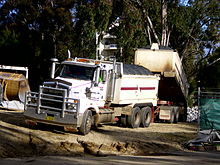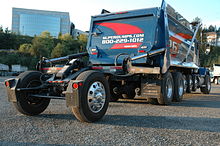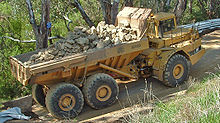- Dump truck
-
For other uses, see Dump truck (disambiguation).
A dump truck (or, UK, dumper truck) is a truck used for transporting loose material (such as sand, gravel, or dirt) for construction. A typical dump truck is equipped with a hydraulically operated open-box bed hinged at the rear, the front of which can be lifted up to allow the contents to be deposited on the ground behind the truck at the site of delivery. In the UK and Australia the term applies to off-road construction plant only, and the road vehicle is known as a tipper, tipper lorry (UK) or tip truck (AU).
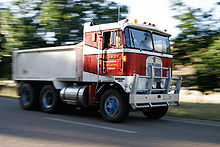 A Kenworth K-100 dump truck
A Kenworth K-100 dump truck
 Isuzu NPR 300 Tipper
Isuzu NPR 300 Tipper
Contents
- 1 Types of dump trucks
- 2 Dangers
- 3 See also
- 4 References
- 5 Notes
- 6 External links
Types of dump trucks
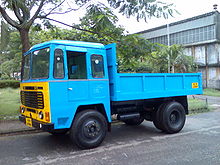 An Ashok Leyland Comet dump truck, this is a good example of a very basic 2 x 4 dump truck used for payloads of 10 metric tons (11.0 short tons; 9.8 long tons) or less
An Ashok Leyland Comet dump truck, this is a good example of a very basic 2 x 4 dump truck used for payloads of 10 metric tons (11.0 short tons; 9.8 long tons) or less
The dump truck was first conceived in Saint John, New Brunswick when Robert T. Mawhinney attached a dump box to a flat bed truck in 1920. The lifting device was a winch attached to a cable that fed over sheave (pulley) mounted on a mast behind the cab. The cable was connected to the lower front end of the wooden dump box which was attached by a pivot at the back of the truck frame. The operator turned a crank to raise and lower the box.[1][2] Today, virtually all dump trucks operate by hydraulics and they come in a variety of configurations each designed to accomplish a specific task in the construction material supply chain.
Standard dump truck
A standard dump truck is a truck chassis with a dump body mounted to the frame. The bed is raised by a hydraulic ram mounted under the front of the dumper body between the frames, and the back of the bed is hinged at the back to the truck. The tailgate can be configured to swing on hinges or it can be configured in the "High Lift Tailgate" format wherein pneumatic rams lift the gate open and up above the dump body.
In the United States, a standard dump truck has one front axle, and one or more rear axles which typically have dual wheels on each side. Rear axles are either powered or unpowered. Most unpowered rear axles can be raised off the pavement, to minimize wear and tear when the truck is unloaded or lightly loaded, and lowered to become load-bearing when the truck needs the extra support. These are referred to as lift axles or drop axles. Lift axles can be steerable or non-steerable; steerable lift axles are always configured with single wheels on each side, instead of dual wheels. Lift axles positioned in front of the powered axles are called pushers; lift axles positioned behind the powered axles are called tags. A trailing tag is a special type of tag mounted on an arm that extends 12 to 15 ft (3.66 to 4.57 m) behind the truck frame to extend the overall outer bridge length of the vehicle.
Common configurations for a standard dump truck include the six wheeler which has one powered rear axle, the ten wheeler with two powered rear axles, the tri-axle with one lift axle and two powered axles, and the quad with two lift axles and two powered axles.. The largest of the standard dump trucks is commonly called a "centipede" and has seven axles. The rear two axles are powered, the front axle is the steering axle, and the remaining four are lift axles. The intermediate axles are present to support the weigh over the length of the chassis and sometimes to provide additional braking power. In the European Union, the dump truck configurations are 2, 3 and 4 axles. The 4 axle eight wheeler has 2 axles at the front and 2 at the rear[notes 1] and is limited to 32 metric tons (35 short tons; 31 long tons) gross weight in most EU countries.[3]
The short wheelbase of a standard dump truck makes it more maneuverable than the higher capacity semi-trailer dump trucks.
Transfer dump truck
A transfer dump is a standard dump truck which pulls a separate trailer which can also be loaded with aggregate (gravel, sand, asphalt, klinkers, snow, wood chips, triple mix, etc.)
The second aggregate container, (B box)[4] on the trailer, is powered by either an electric, pneumatic motor or hydraulic line,. It rolls on small wheels, riding on rails from the trailer's frame, into the empty main dump (A) box. This maximizes payload capacity without sacrificing the maneuverability of the standard dump truck. Transfer dumps are typically seen in the western United States because of the peculiar weight restrictions on western highways.
Another configuration seen is called a Triple Transfer Train, which consists of a B and C box. These are common on Nevada and Utah Highways but not in California. Depending on the axle arrangement, a Triple Transfer can haul up to 129,000 kilograms (280,000 pounds) with a special permit in certain US states. The Triple Transfer usually costs a contractor about $105 an hour while a A/B config usually runs about $85 per hour (2007 stats).
Transfer dump trucks typically haul between 26 and 27 short tons (23.6 and 24.5 t; 23.2 and 24.1 long tons) of aggregate per load, each truck is capable of 3-5 loads per day, generally speaking.
Truck and pup
A truck and pup is very similar to a transfer dump. It consists of a standard dump truck pulling a dump trailer. The pup trailer, unlike the transfer, has its own hydraulic ram and is capable of self-unloading.
Superdump truck
A Superdump is a straight dump truck equipped with a trailing axle, a liftable, load-bearing axle rated as high as 13,000 pounds (5,897 kg). Trailing 11 to 13 feet (3.35 to 3.96 m) behind the rear tandem, the trailing axle stretches the outer "bridge" measurement—the distance between the first and last axles—to the maximum overall length allowed. This increases the gross weight allowed under the federal bridge formula, which sets standards for truck size and weight. Depending on the vehicle length and axle configuration, Superdumps can be rated as high as 80,000 pounds (36,287 kg). GVW and carry 26 short tons (23.6 t; 23.2 long tons) of payload or more. When the truck is empty or ready to offload, the trailing axle toggles up off the road surface on two hydraulic arms to clear the rear of the vehicle. Truck owners call their trailing axle-equipped trucks Superdumps because they far exceed the payload, productivity, and return on investment of a conventional dump truck. The Superdump and trailing axle concept was developed by Strong Industries of Houston, Texas.
Semi trailer end dump truck
A semi end dump (or "pony dump") is a tractor-trailer combination wherein the trailer itself contains the hydraulic hoist. A typical semi end dump has a 3-axle tractor pulling a 2-axle semi-trailer. The key advantage of a semi end dump is rapid unloading. A key disadvantage is that they are very unstable when raised in the dumping position limiting their use in many applications where the dumping location is uneven or off level.
Semi trailer bottom dump truck
A semi bottom dump (or "belly dump") is a 3-axle tractor pulling a 2-axle trailer with a clam shell type dump gate in the belly of the trailer. The key advantage of a semi bottom dump is its ability to lay material in a wind row (a linear heap). In addition, a semi bottom dump is maneuverable in reverse, unlike the double and triple trailer configurations described below. These trailers may be found either of the windrow type shown in the photo, or may be of the 'cross spread' type with the gates opening front to rear instead of left and right. The cross spread gates will actually spread gravel fairly evenly the width of the trailer. by comparison, the windrow gates leave a pile in the middle. The cross spreads jam and do not work well with larger materials. Likewise they are not suitable for use where spreading is not desired such as when hot asphalt paving material is being dumped into a paving machine.
Double and triple trailer bottom dump truck
Double and triple bottom dumps consist of a 2-axle tractor pulling one single-axle semi-trailer and an additional full trailer (or two full trailers in the case of triples). These dump trucks allow the driver to lay material in windrows without leaving the cab or stopping the truck. The main disadvantage is the difficulty in backing double and triple units.
The specific type of dump truck used in any specific country is likely to be closely keyed to the weight and axle limitations of that jurisdiction. Rock, dirt and other types of materials commonly hauled in trucks of this type are quite heavy, and almost any style of truck can be easily overloaded. Because of that, this type of truck is frequently configured to take advantage of local weight limitations to maximize the cargo. For example, within the United States, the maximum weight limit of 40 short tons (36.3 t; 35.7 long tons) throughout the country, except for specific bridges with lower limits. Individual states, in some instances, are allowed to authorize trucks up to 52.5 short tons (47.6 t; 46.9 long tons). Most states that do so require that the trucks be very long, to spread the weight over more distance. It is in this context that double and triple bottoms are found within the US.
Side dump truck
A side dump truck(S.D.T)consists of a 3-axle tractor pulling a 2-axle semi-trailer. It has hydraulic rams which tilt the dump body onto its side, spilling the material to either the left or right side of the trailer. The key advantages of the side dump are that it allows rapid unloading and can carry more weight in western United States. In addition, it is almost immune to upset (tipping over) while dumping unlike the semi end dumps which are very prone to tipping over. It is, however, highly likely that a side dump trailer will tip over if dumping is stopped prematurely. Also, when dumping lose materials or cobble sized stone, the side dump can become stuck if the pile becomes wide enough to cover too much of the trailer's wheels. Trailers that dump at the appropriate angle (50° for example) avoid the problem of the dumped load fouling the path of the trailer wheels by dumping their loads further to the side of the truck, in some cases leaving sufficient clearance to walk between the dumped load and the trailer.
Winter service vehicles
Many winter service vehicle units are based on dump trucks, to allow the placement of ballast to weigh the truck down or to hold sodium or calcium chloride salts for spreading on snow and ice covered surfaces.
Off-highway dump trucks
Off-highway dump trucks [5] are heavy construction equipment and share little resemblece to highway dump trucks. Bigger off-highway dump trucks are used strictly off-road for mining and heavy dirt hauling jobs. There are two primary forms: rigid frame and articulating frame.
The term ‘dump’ truck is not generally used by the mining industry, or by the manufacturers that build these machines. The more appropriate U.S. term for this strictly off road vehicle is "haul truck" and the equivalent European term is 'dumper'.
Haul truck
Main article: Haul truckFor usage in large surface mines and quarries haul trucks is used. They have a rigid frame and conventonal steering with drive at the rear wheel. The largest are the Liebherr T 282B, the Bucyrus MT6300AC and the Caterpillar 797F, which each have payload capacities of up to 400 short tons (363 t; 357 long tons). Most large size haul trucks employ diesel/electric powertrains, using the diesel engine to drive an AC alternator or DC generator that sends electric power to electric motors at each rear wheel. The Caterpillar 797 is unique for its size as it employs a diesel engine to power a mechanical powertrain typical of most road going vehicles and intermediary size haul trucks. Other major manufacturers of haul trucks include Hitachi, Komatsu, DAC, Terex and Belaz.
Articulated hauler
Main article: Articulated haulerAn articulated hauler is an all-wheel drive, off-road dump truck. It has a hinge between the cab and the dump box, but is distinct from a semi-trailer truck in that the power unit is a permanent fixture, not a separable vehicle. Steering is accomplished via hydraulic cylinders that pivot the entire tractor in relation to the trailer, rather than rack and pinion steering on the front axle as in a conventional dump truck. By this way of steering, the trailers wheels follow the same path as the front wheels. Together with all-wheel drive and low center of gravity, it is highly adaptable to rough terrain. Major manufacturers include Volvo CE, Terex and Caterpillar.
Dangers
Collisions
Dump trucks are normally built for some amount of off-road or construction site driving; as the driver is protected by the chassis and height of the driver's seat, bumpers are either placed high or omitted for added ground clearance. The disadvantage is that in a collision with a standard car, the entire motor section or luggage compartment goes under the truck. Thus the passengers in the car could be more severely injured than would be common in a collision with another car. Several countries have made rules that new trucks should have bumpers approximately 40 cm (16 in) above ground in order to protect other drivers better. There are also rules about how long the load or construction of the truck can go beyond the rear bumper to prevent cars that rear-end the truck from going under it.[6]
Tipping
Another safety consideration is the leveling of the truck before unloading. If the truck is not parked on relatively horizontal ground, the sudden change of weight and balance due to lifting of the skip and dumping of the material can cause the truck to slide, or even—in some light dump trucks—to turn over.
Back-up accidents
Because of their size and the difficulty of maintaining visual contact with on-foot workers, dump trucks in car parks can be a threat, especially when backing up.[7] Mirrors and back-up alarms provide some level of protection, and having a spotter working with the driver also decreases back-up injuries and fatalities.[8]
See also
Manufacturers
- Ashok Leyland
- Enrika with Belaz - BelazEnrika
- Asia Motor Works
- BEML
- Specialized Truck Equipment Manufacturing LLC
- BelAZ
- Kenworth
- Case
- Caterpillar Inc.
- Daimler AG
- Doosan Moxy
- Euclid Trucks
- GHH Fahrzeuge
- Henderson Products
- Hitachi Construction Machinery
- Hitachi Construction Machinery (Europe)
- International
- Komatsu
- Leader Trucks
- Liebherr
- Mack Trucks
- MAN
- New Holland
- Peterbilt
- Raglan Industries
- SAICO Tipping Bodies manufactury
- ST Kinetics
- Tata
- Tata Daewoo
- Tatra (company)
- Terex Corporation
- Volvo
- Volvo Construction Equipment
Vehicle types
Other
References
- ^ Mario Theriault, Great Maritme Inventions 1833-1950, Goose Lane Editions, 2001, p. 71
- ^ Sketch of the first dump truck
- ^ http://www.rsa.ie/SERVICES/upload/File/Vehicle%20Standards/Leaflet%20No.%201.doc retrieved 15-Jan-2010
- ^ http://www.youtube.com/watch?v=woi0T4XVf1s
- ^ http://www.bcmuseumofmining.org/pdfs/The_Super_Haul_Truck_Resource.pdf
- ^ http://www.wipo.int/pctdb/en/wo.jsp?IA=SE2003001950&DISPLAY=DESC Vehicles underrun protection arrangements Retrieved 2008-12-26
- ^ A Laborer Dies in a Street Work Zone after Being Backed Over by a Dump Truck. Fatality Assessment and Control Evaluation (FACE) Program. National Institute for Occupational Safety and Health. California Case Report: 07CA001.
- ^ A Construction Inspector Dies After Being Backed Over by a Ten-wheel Asphalt Dump Truck. Fatality Assessment and Control Evaluation (FACE) Program. National Institute for Occupational Safety and Health. California FACE Investigation 00CA005.
Notes
- ^ In the UK, it is more common to refer to the number of wheel hubs, rather than the number of tires
External links
Categories:- Dump trucks
- Trucks
- Engineering vehicles
- Canadian inventions
Wikimedia Foundation. 2010.



